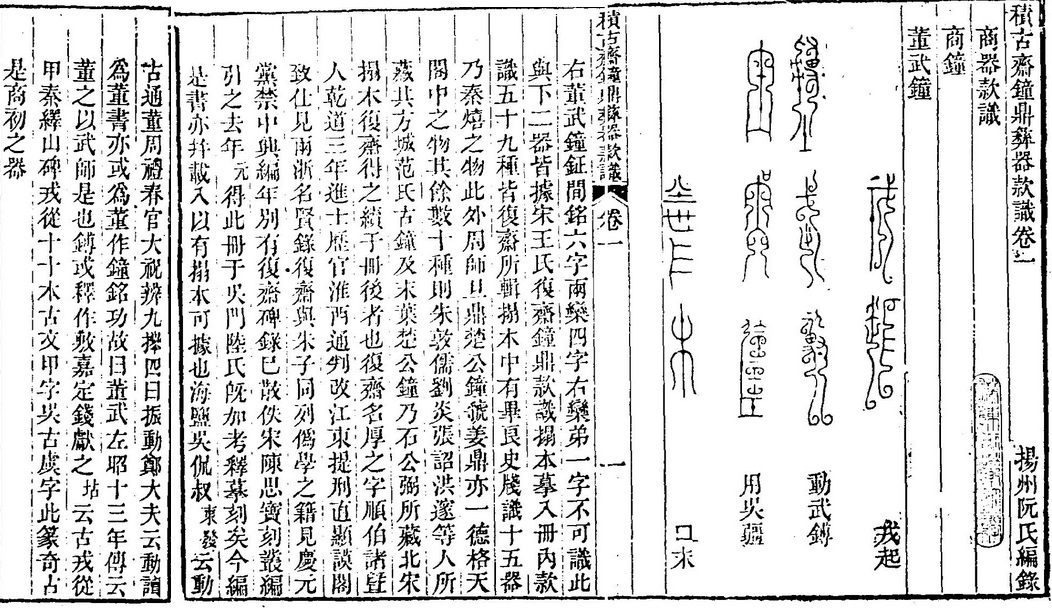Jiguzhai zhongding yiqi kuanzhi 積古齋鐘鼎彝器款識 is a book on bronze inscriptions compiled during the late Qing period 清 (1644-1911) by Ruan Yuan 阮元 (1764-1849). The expression kuanzhi 款識 (with a special reading of 識) means "characters or patterns on ancient bronze objects", and is also used for a title written on paintings and calligraphies.
Ruan Yuan had the book printed in 1804. It found later entry in the series Wenjuanlou congshu 文選樓叢書 and was variously reprinted, namely in 1879 by the Chongwen Shuju 崇文書局, 1888 by the Baofang Studio 抱芳閣 (a version which was part of the series Houzhibuzuzhai congshu 後知不足齋叢書), and in 1937 in the series Congshu jicheng chubian 叢書集成初編. It is also included in Ruan's own series Huang-Qing jingjie 皇清經解, which actually focuses on commentaries on the Confucian Classics.
As an enthusiast collector of ancient bronze vessels, Ruan Yuan was of the opinion that he had the scholarly duty to conserve the inscriptions by rubbing, archiving and publishing them. He saw his catalogue in the tradition of Xue Shanggong's 薛尚功 (fl. 1144) Lidai zhongding yiqi kuanzhi fatie 歷代鐘鼎彝器款識法帖, which reproduced inscriptions of ancient bells and sacrificial bronze vessels from the Shang 商 (17th-11th cent. BCE) and Zhou 周 (11th cent.-221 BCE) periods. For this reason, Ruan and his colleagues Jiang Deliang 江德量 (1752-1793), Zhu Weibi 朱為弼 (1771-1840), Sun Xingyan 孫星衍 (1753-1818), and Zhao Bingchong 趙秉衝 (d. 1814) who likewise owned collections of ancient objects, put together their holdings and contributed to a catalogue of 10 juan length which presents 173 objects from the Shang period, 273 from the Zhou, 5 from the Qin 秦 (221-206 BCE), 92 from the Han 漢 (206 BCE-220 CE), 3 from the Wei 曹魏 (220-265), and 4 from the Jin period 晉 (265-420), 551 pieces in total. The ancient inscriptions are reproduced and transcribed in to modern script.
 |
The figure shows the drawing of an inscription of the Dong Wu zhong bell 董武鐘 (動武鐘), with the original characters above and the transcription into modern script below. The inscription is a reproduction of the book Fuzhai zhongding kuanzhi 復齋鐘鼎款識 of Wang Houzhi 王厚之 (1131-1204). Ruan wrongly identified this object as a Shang-period musical instrument, but it must in fact be dated to the Warring States period 戰國 (5th cent.-221 BCE). |
The book is divided into two parts, the first, larger one reproducing inscriptions of bronze vessels, the second one such of weapons. The first chapter discusses the meaning of bronze inscriptions and compares them to statements in the Confucian Classis. The next part explains the cultural importance of bells and the large sacrificial vessels during antiquity and their rediscovery during the Tang 唐 (618-907) and Song 宋 (960-1279) periods.
The chapter on weapons reveils the authors' observation that in the age of antiquity swords were particularly short in comparison with later ages.
For all his merits, Ruan Yuan must also be criticised in some points, mainly for wrong chronological order in many cases (Dong Wu zhong 董武鐘, Mu ding 木鼎 and Longhu tongjie 龍虎銅節), including forgeries from the Song period (like Jiali zun 嘉禮尊, Jiawu gui 甲午簋 and Tianxi gui 天錫簋), and errors in transcription and the reproduction of rubbings.
Ruan's catalogue inspired a series of younger studies on ancient inscriptions like Zheng Yexue's 鄭業斅 Duxiaozhai jin-shiwen kao 獨笑齋金石文考, Fang Junyi's 方濬益 (d. 1899, also written 方浚益) Zhuiyizhai yiqi kaoshi 綴遺齋彝器考釋, Wu Dacheng's 吳大澂 (1835-1902) Kezhai jigu lu 愙齋集古錄, Sun Yirang's 孫詒讓 (1848-1908) Guzhou shiyi 古籀拾遺 or Rong Geng's 容庚 (1894-1983) Shang-Zhou yiqi tongkao 商周彝器通考.
Zhu Weibi's collection of inscriptions, called Jijin guwen shi 吉金古文釋, was in 1906 published as a kind of draft to Ruan's book called Jiguzhai ding-zhong-yi qi kuanzhi gaoben 積古齋鐘鼎彝器款識稿本, with a length of 4 juan.